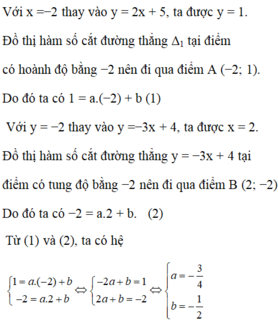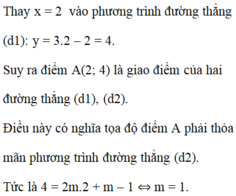Hãy nhập câu hỏi của bạn vào đây, nếu là tài khoản VIP, bạn sẽ được ưu tiên trả lời.

a) Vì đồ thị hàm số ax+b song song với (d1) nên a=3
hay hàm số có dạng là y=3x+b
Vì đồ thị hàm số y=3x+b đi qua điểm C(3;-2)
nên Thay x=3 và y=-2 vào hàm số y=3x+b, ta được:
\(3\cdot3+b=-2\)
\(\Leftrightarrow b+9=-2\)
hay b=-11
Vậy: Hàm số có dạng là y=3x-11
b) Vì (d)⊥(d2) nên \(a\cdot4=-1\)
hay \(a=-\dfrac{1}{4}\)
Vậy: Hàm số có dạng là \(y=-\dfrac{1}{4}x+b\)
Vì (d) đi qua D(2;-1) nên
Thay x=2 và y=-1 vào hàm số \(y=-\dfrac{1}{4}x+b\), ta được:
\(-\dfrac{1}{4}\cdot2+b=-1\)
\(\Leftrightarrow b-\dfrac{1}{2}=-1\)
hay \(b=-\dfrac{1}{2}\)
Vậy: \(a=-\dfrac{1}{4}\) và \(b=-\dfrac{1}{2}\)

Vì parabol đi qua \(I\left(-2;1\right)\) nên \(\left\{{}\begin{matrix}\dfrac{b}{2a}=2\\-\dfrac{\Delta}{4a}=1\end{matrix}\right.\Leftrightarrow\left\{{}\begin{matrix}4a-b=0\\b^2-4ac-4a=0\end{matrix}\right.\)
\(\Leftrightarrow\left\{{}\begin{matrix}b=4a\\16a^2-4ac-4a=0\end{matrix}\right.\Leftrightarrow\left\{{}\begin{matrix}b=4a\\4a-c=1\left(a\ne0\right)\end{matrix}\right.\Leftrightarrow\left\{{}\begin{matrix}b=4a\\4a=1+c\end{matrix}\right.\)
Mà parabol cắt \(y=x-1\) tại 1 điểm trên trục tung nên \(x=0\Leftrightarrow y=1\)
\(\Leftrightarrow c=1\Leftrightarrow\left\{{}\begin{matrix}a=\dfrac{1}{2}\\b=2\end{matrix}\right.\)
Vậy parabol là \(y=\dfrac{1}{2}x^2+2x+1\)

Tọa độ A là nghiệm: \(\left\{{}\begin{matrix}x+y-1=0\\3x-y+5=0\end{matrix}\right.\) \(\Rightarrow A\left(-1;2\right)\)
Gọi \(\alpha\) là góc giữa d1 và d2 \(\Rightarrow cos\alpha=\frac{\left|3-1\right|}{\sqrt{2}.\sqrt{10}}=\frac{\sqrt{5}}{5}\)
Do \(AB=BC\Rightarrow\Delta ABC\) cân tại B
Gọi \(\beta\) là góc giữa \(\Delta\) và \(d_1\) \(\Rightarrow\alpha=\beta\)
Giả sử \(\Delta\) nhận \(\left(a;b\right)\) là vtpt
\(\Rightarrow\frac{\left|a+b\right|}{\sqrt{2}\sqrt{a^2+b^2}}=\frac{\sqrt{5}}{5}\)
\(\Leftrightarrow5\left(a+b\right)^2=2\left(a^2+b^2\right)\)
\(\Leftrightarrow3a^2+10ab+3b^2=0\Rightarrow\left[{}\begin{matrix}3a=-b\\a=-3b\end{matrix}\right.\)
\(\Rightarrow\Delta\) có 2 vtpt là \(\left(1;-3\right);\left(3;-1\right)\)
Có 2 pt đường thẳng thỏa mãn:
\(\left[{}\begin{matrix}1\left(x-2\right)-3\left(y-2\right)=0\\3\left(x-2\right)-1\left(y-2\right)=0\end{matrix}\right.\)

Do A thuộc d1 nên tọa độ có dạng \(A\left(a;3a-3\right)\)
Do B thuộc d2 nên tọa độ có dạng: \(B\left(b;-b-2\right)\)
Áp dụng công thức trung điểm:
\(\Rightarrow\left\{{}\begin{matrix}a+0=2b\\3a-3+2=2\left(-b-2\right)\end{matrix}\right.\)
\(\Rightarrow\left\{{}\begin{matrix}a-2b=0\\3a+2b=-3\end{matrix}\right.\) \(\Rightarrow\left\{{}\begin{matrix}a=-\dfrac{3}{4}\\b=-\dfrac{3}{8}\end{matrix}\right.\)
\(\Rightarrow\left\{{}\begin{matrix}A\left(-\dfrac{3}{4};-\dfrac{21}{4}\right)\\B\left(-\dfrac{3}{8},-\dfrac{13}{8}\right)\end{matrix}\right.\) \(\Rightarrow\overrightarrow{AB}=\left(\dfrac{3}{8};\dfrac{29}{8}\right)\)
Phương trình d có dạng:
\(29x-3\left(y-2\right)=0\Leftrightarrow29x-3y+6=0\)

(2): =>(4x^2-1)(x^2-6x+9)<=0
=>(4x^2-1)(x-3)^2<=0
TH1: (4x^2-1)(x-3)^2=0
=>x=3 hoặc \(x\in\left\{\dfrac{1}{2};-\dfrac{1}{2}\right\}\)
TH2: (4x^2-1)(x-3)^2<0
=>4x^2-1<0
=>-1/2<x<1/2



Pt tọa độ giao điểm d1 và d2:
\(\left\{{}\begin{matrix}y=3x-5\\y=4x-9\end{matrix}\right.\) \(\Leftrightarrow\left\{{}\begin{matrix}3x-y=5\\4x-y=9\end{matrix}\right.\) \(\Rightarrow\left\{{}\begin{matrix}x=4\\y=7\end{matrix}\right.\)
\(\Rightarrow M\left(4;7\right)\)
Do đồ thị hàm bậc 2 đã cho qua A và M nên ta có:
\(\left\{{}\begin{matrix}3.\left(-2\right)^2+\left(-2\right)b+c=1\\3.4^2+4b+c=7\end{matrix}\right.\)
\(\Leftrightarrow\left\{{}\begin{matrix}-2b+c=-11\\4b+c=-41\end{matrix}\right.\) \(\Rightarrow\left\{{}\begin{matrix}b=-5\\c=-21\end{matrix}\right.\)
\(\Rightarrow y=x^2-5x-21\)